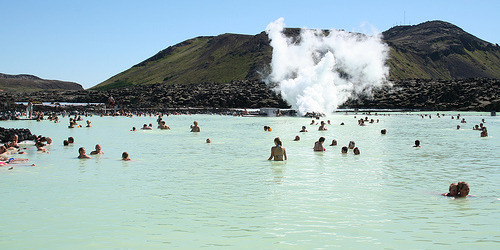Soaking in the Blue Lagoon
 The Blue Lagoon is Iceland’s most famous attraction. A pool of superheated neon blue water, it is believed to have restorative effects and is visited by over 400,000 people each year.
The Blue Lagoon is Iceland’s most famous attraction. A pool of superheated neon blue water, it is believed to have restorative effects and is visited by over 400,000 people each year.
What is the Blue Lagoon?
A popular misconception is that the Blue Lagoon is a naturally occurring hot spring pool, and while the country does have many, this is not one of them. The water that fills the Blue Lagoon actually comes from a nearby geothermal power plant. The hot water (about 464 degrees Fahrenheit) comes from over 6,000 feet deep below the ground and is used to create electricity for the nearby city of Reykjavik.
When it was built, the plant’s creators thought the run-off water would soak back into the earth, but the silica in the water forms a bottom layer on the ground and keeps it from being absorbed back into the ground fast enough. So it was decided that the water, which despite its industrial use is pure spring water from the ground, could be utilized for a spa and bathing area. The Blue Lagoon was built in 1991; since then it has welcomed nearly four million people.
The water in the Lagoon gets its color from the rich mineral and sulfur content and it steams because, well, it’s really hot. The water temperature averages about 104 degrees Fahrenheit, though you will find varying hot and cold spots as you move around the Lagoon, which has different depths and areas for relaxation, including ledges for sitting and small caves for privacy.
Services offered at the Blue Lagoon
Most who people come to the Blue Lagoon to soak for an hour or so and then they leave. You could, however spend a whole day here, and even a night. There is a spa onsite, which offers treatments including massages under the Blue Lagoon waterfall, in-water salt and silica scrubs and massages, and facials (performed indoors). There’s an onsite restaurant, café, and bar, all with views of the Blue Lagoon, and an onsite hotel and conference center.
How to get to the Blue Lagoon
The easiest way to get to the Blue Lagoon is to drive. If you’re coming from Reykjavik, it takes 40 minutes to get there. It’s only 20 minutes from Keflavik Airport though, so many people choose to stop at the Blue Lagoon on their way to or from the Airport.
>>more on getting from Reykjavik to the Blue Lagoon
Hours and Admission
The Blue Lagoon is open during winter from 10am to 8pm and during summer from 9am to 9pm. Guests can stay in the Lagoon for up to 45 minutes past closing time.
Visitors can pay in kronur or euro, with cash or credit. Admission is 23 Euros per adult; towel and bathing suit rental are 4 Euros each, and bathrobes can be rented for 7 Euros. Small lockers are available for storage of luggage. While they won’t hold large cases, they will hold most carry-on bags.
Tips for visiting the Blue Lagoon
- While many people suggest stopping at the Blue Lagoon to relax and unwind before your leave for your flight home, I recommend making it your first stop in the country upon arrival. There’s no better introduction to the dichotomies of Iceland, I think, than by walking through snow and ice to a super-heated hot spring and relaxing in the steaming blue waters as snowflakes land in your hair.
- Speaking of hair, you’ll see signs in the showers (it is mandatory to shower before getting into the Blue Lagoon – Icelanders are very concerned with proper hygiene) suggesting you coat your hair with conditioner before you soak. Do not take this warning lightly. The silica and other properties of the Blue Lagoon water will do a number on your hair. My first time, I didn’t put enough conditioner in, and for three days after my soak, my hair had a feel to it that can only be described as “chewy”. Load up the conditioner.
- Aside from the havoc it will wreak on your hair, silica does have some healing properties and is very good for your skin. This is why you’ll see people in the Lagoon taking silica from jars placed around the edges (or just reaching down to grab some from the bottom of the Lagoon) and smearing it on their skin. This is also why you’ll see expensive jars of it sold around Iceland. Save yourself some money. Bring a small container into the Lagoon with you and take a little silica to go.
Photo by Ewan McIntosh